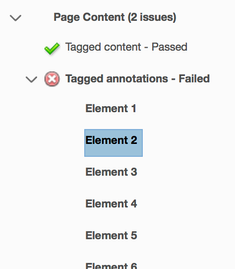- Home
- Acrobat
- Discussions
- Acrobat Accessibility – "Tagged Annotations Failed...
- Acrobat Accessibility – "Tagged Annotations Failed...
Copy link to clipboard
Copied
I have a Master Page footer with a URL in InDesign. When exported, the URL is a clickable hyperlink.
But when I run an Accessibility check in Acrobat, all footer instances on all pages fail "tagged annotations."
The footer URL is not tagged in the Tags view. In the Content view, it exists as a "Link" under Annotations and as a Container <Artifact>.
How do I fix this?
Copy link to clipboard
Copied
Copy link to clipboard
Copied
Hi,
You can fix the issue by making annotations as artifact in Content panel or include in the Tags tree. For further info related to failure, Right Click on "Element 1" and Select Explain. If it still can't fix the issue, I would request you to provide us a file so that we can help you with more accurate information.
Thanks
Rachit
Copy link to clipboard
Copied
Copy link to clipboard
Copied
Thanks so much for finding/sharing this fix!
Copy link to clipboard
Copied
When you write "by going Tags..." how do you "go Tags". After a lot of hovering, I found in a right-hand icon menu a small 5-sided image that looks like a luggage tag. (I only understood this after mouse-hovering. Have mercy on keyboard-only users.)
Copy link to clipboard
Copied
coopjack wrote: "I was able to fix this by going Tags > Find… > Unmarked Annotations and Acrobat created all the Link - OBJR tags necessary."
That is one technique to correct hyperlinks that are missing the OBJR sub-tag.
However, although your PDF now passes the Acrobat checker, it still is not accessible per the PDF/UA-1 and WCAG accessibility standards. These apply to your document:
- 7.8 -- Page headers and footers: Running headers and footers shall be identified as Pagination artifacts, and
- Avoid redundency. That is, the same information repeated multiple times, such as headers and footers, logos that appear on every page, and the same hyperlink on each page.
Software accessibility checkers like the one in Acrobat Pro and by other manufacturers, can't check and test for about 1/3 of the accessibility requirements. They require a human with knowledge of accessibility standards to determine if the file is fully accessible.
In your design, even with the footer artifacted, the hyperlink will be caught by some assistive technologies and be voiced on each page over and over, possibly in the middle of a sentence as text flows from one page to the next.
In my 508 InDesign classes, I call this a Catch-22 trap: If you leave a live hyperlink but it doesn't have the OBJR sub-tag, then it fails most accessibility checkers. But if you correct that and add the OBJR sub-tag, now you have a redundency error as well as live, tagged header/footer information that should be artifacted.
Here are some ways to get your design out of this Catch 22 dilemma:
- Easiest: don't put hyperlinks in repeating page headers and footers. Instead, put hyperlinks in the live body content of your document.
- If you must put a hyperlink in a header of footer (such as you have a client who requires this), then remove the hyperlink in InDesign and in the PDF. It won't be clickable for anyone (whether they use assistive technology or not), but the design will pass accessibility tests.
The best solution is to design a document that avoids and prevents the problem from the beginning. And that's why we're called "designers"!
Hope this helps.
| PubCom | Classes & Books for Accessible InDesign, PDFs & MS Office |
Copy link to clipboard
Copied
Hello,
I am working on an annual report of 160 pages and trying to make it also accessible.
In this document we have main navigation at footer, with links to different sections so they are hyperlinks that refers to certain pages in the document. And it is located in the master page at InDesign document. At least me and my clients find this navigation very useful and user-friendly in this large pdf documetn. But at the Acrobat accessibility full check I get 1345 elements showing failure in tagged annotations... (Some pages have main menu & sub menu).
Is this a lost case or is there any solutions for this kind of problem? I think removing this “footer navigation menu” is not an option. It would break my heart to remove the menu from master page and put it on the 158 (or so) pages...
Best regards
Paula Venäläinen
Graphic Designer
Copy link to clipboard
Copied
@PaulaVenalainen, headers and footers are deliberately not read by assistive technologies for significant reasons: they 1) are repetitive information, which is not allowed per our accessibility standards, and 2) they can break up the reading order when main content flows from one page to the next: where would you have the footer come into the reading order? In mid-sentence? Mid-paragraph?
Therefore, accessibility standards require all footers and headers be artifacted (except for maybe the first instance). Assistive technologies give their users a way to announce what page they are on.
Your design doesn't coordinate with this accessibility requirement. As described above, when a hyperlink is artifacted (so that it doesn't repeat for assistive technologies), it becomes an annotation error.
If your PDF has bookmarks (which it should because it's longer than 10 pages), wouldn't that give users the same functionality as a complex navigation system in the footer? Base the bookmarks on the different levels of headings and they can have nested sub-sections.
- An InDesign TOC can automatically generate bookmarks in the exported PDF.
- You can also manually add InDesign bookmarks that will be exported to the PDF, too.
See https://helpx.adobe.com/ca/indesign/using/bookmarks.html#create_bookmarks_for_pdf
| PubCom | Classes & Books for Accessible InDesign, PDFs & MS Office |
Copy link to clipboard
Copied
Thank you for your swift answer, you have excellent points!
I will suggest that we should make an own version of this document for the assistive technologies.
And of course I have a TOC too. Actually we have 4 pages of bookmarked TOCs here, located at the the start of every section (that footer navigation goes to these TOC pages so user can navigate forward from there). All those TOCs have at least two levels of headings too.
Copy link to clipboard
Copied
You're very welcome.
And best to you and this project!
| PubCom | Classes & Books for Accessible InDesign, PDFs & MS Office |

Copy link to clipboard
Copied
Hi, I would like to output a PDF file that is 100% ADA compliant (or as close as I can get). I am running into issues left and right and the documentation is terrible. There seem to be lots of loose ends in the documentation and bugs. For example, the 'Title Failed' issue in PDF files. I have gone in at the InDesign level and added the 'Document Title, Description, Keywords etc. into the File Info area and yet Acrobat STILL continues to flag it as an issue. Why?! I am also trying to remedy the 'Tagged Form Fields - Failed' issue and have found documentation stating the I need to tag the form fields, BUT 'the frame or frame content is not taggable'. Ugh, And I am getting dinged on 'tagged annotations' for the TOC which I have found lots of documentation to fix within the PDF, but I would like to generate an already accessible PDF and apply whatever is needed at the ID level. Lastly, I have added the proper alt text for links throughout my document but once again, I need to go into the PDF and add these alt tags yet again once I have generated the PDF. Please help.
Copy link to clipboard
Copied
This is absolutely horrifyingly painstaking considering it is 2024 and Adobe owns both of these programs. Why is making a document accessible so impossible? I followed the instructions, several times and the suggested techniques simply do not work. Adobe is the standard for all things web or print but we are unable to meet federal and state required accessibility by using the products.
Copy link to clipboard
Copied
@Debbie5C13 and @Deleted User,
It IS possible to create a fully accessible PDF from InDesign, Word, and other source authoring programs.
However, the problems described in your posts are due to:
- Elements not sufficiently created or designated for tags in the source document. (user error)
- Settings not correctly set in the Export to PDF dialogues. (user error)
There is a lot to learn about how to make a source file so that it exports to an accessible PDF, including an accessible form, but the details are too numerous to detail here. And, so much about accessibilty depends upon the document itself and what's the best technique to make it accessible — there is no one-size-fits-all method to make a PDF accessible, and neither Adobe nor Microsoft nor any other company is responsible for how you create the source file and then export the PDF.
I encourage you to take a class (live or canned online video) to learn the details (like forms, accessible hyperlinks, titles, TOCs, etc.). There are many options out there, just search for it and learn.
| PubCom | Classes & Books for Accessible InDesign, PDFs & MS Office |
Copy link to clipboard
Copied
Debbie
--------------------------------------------------------------------------------------------------------------
Debbie McDonald | Publication Specialist III
Alaska Department of Health | Communications Team
office: 907-269-7865 | cell: 907-720-3794
--------------------------------------------------------------------------------------------------------------
This email/attachment(s) is for the addressee only, and may contain protected confidential information. Dissemination, distribution or copying by anyone else is prohibited. If you've received this email in error, please let me know by reply email and delete this email immediately. Thank you.
Love and laughter fuel the soul.
Copy link to clipboard
Copied
In InDesign, elements on master pages, such as page numbers or running titles, graphics/design elements, are typically treated as artifacts by default, meaning they are ignored by assistive technology. If you want them tagged as hyperlinks by default, don't put them on any master page.
Get ready! An upgraded Adobe Community experience is coming in January.
Learn more




